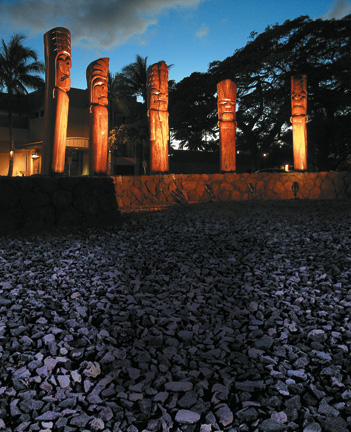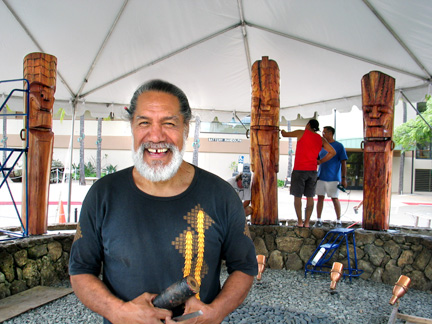
Warriors’ spot
 marks the locations where memories reside, by artifact and artifice, by determined design and often by neglect. As the Beatles sang, 'There are places I'll remember / All my life, 'tho some have changed / Some forever, not for better / Some have gone, and some remain ...'
marks the locations where memories reside, by artifact and artifice, by determined design and often by neglect. As the Beatles sang, 'There are places I'll remember / All my life, 'tho some have changed / Some forever, not for better / Some have gone, and some remain ...'We are territorial animals, and some ground is more sacred than others. Perhaps because of what once occurred there, perhaps of what resides there now, but generally because the site has been deliberately set aside for remembrance and reflection.
Beginning this week and continuing Sundays in the Honolulu Star-Bulletin travel section, "X Marks the Spot," will look at the monuments, memorials, sacred sites and statuary that dot Hawaii's historical and cultural landscape.
War gods stand where
battle histories meet
X MARKS THE SPOT at Kalia, the gateway to Waikiki and the ancient name of Fort DeRussy. On land presented to High Chief Kalanimoku as a reward for bravery during the crucial Battle of Nuuanu, in the shoulder of a mighty seacoast fortress called Battery Randolph, one sees an elegant, stark stand of Hawaiian statuary called kii. The site has become a focal point where ancient and modern Hawaiian military history intersect.
U.S. Army Museum of HawaiiLocationSaratoga Rd. & Kalia Rd. Honolulu, HI 96815 (808) 955-9552
Quicktime VR(s)
|
In the late 1970s, then-director Thomas Fairfull approached Hawaiian artist Rocky Ka'iouliokahikikolo'ehu Jensen with the notion of creating a kukalepa, or memorial to fallen Hawaiian warriors, at the site.
Fairfull wanted a work of mythological power that tied together the past and future, and Jensen designed a landscaped theme as a Hawaiian Stonehenge, rising from the ground like fingers from a hand, each piece similar but with differences. They are aspects of Kunuiakea, the Hawaiian masculine god, popularly known as Ku, the god of war. Each column represents a face of Ku.

Rocky Ka'iouliokahikikolo'ehu Jensen and his kukalepa.
"It's like bringing to life the spirits of the ancestors themselves, using modern techniques on very old art," Jensen said at the time. "This isn't decor. It's not like knocking out a tiki for a hotel lobby. The real challenge was portraying the benign, healing aspects of Ku as well as the warlike. Warfare comes with the territory; it's what happens afterward that counts."
It took 15 years before the museum was able to allow Jensen to pursue his vision, which he did despite an evaporating budget and scoldings from fellow artists who thought he should be cashing in on the feds. But Jensen had always honored his ancestors through his art.
The Army provided space for Jensen to carve native ohia logs, the largest he had ever seen, donated by Charles Medeiros of Honaunau and acquired by Big Island businessman John Kekua.
And then the work space was scheduled for demolition. Space was found at Kilauea Military Camp at Volcano. In the high, cold mana of Kilauea on the steaming lips of the volcano, it took Jensen nearly four years to carve the sculptures.
When the kukalepa was dedicated, Fairfull exclaimed, "It's absolutely magnificent, both on the levels of creativity and scholarship -- it's awesome!"
It was the first time a Hawaiian sacred place had been created since 1808, when Kamehameha commemorated the Battle of Nuuanu.
Even well-loved memorials need a tune-up, and in six years the Na Lehua Helelei monument in Fort DeRussy developed a crust of airborne debris and hardened linseed oil. The 'ohia wood could not breathe, and began to develop cracks.
Thanks to small grants from Bishop Museum and the Office of Hawaiian Affairs plus sweat equity from the Royal Order of Kamehameha, Ka Pa Ku'ialua and Ka Pa Ku'iaholo, Rocky and Lucia Jensen, their family and friends, gathered recently to refurbish the monument, down to hand-washing each base stone.
"So, what started out to be a difficult task, wondering where we would get the help, has developed into a wonderful harmony of voices, all eager to help in the relivening of this amazing monument," said Lucia Jensen.
The 'ohia needed to be scraped and polished, the cracks repaired with slivers of milo and kamani wood, and a protective UV glaze Varathane applied to better protect the wood.
Still, there are surprises. " 'Ohia usually turns grayish out in the sun," mused Jensen. "These have turned reddish. Must be the blood in the wood."
[News] [Business] [Features] [Sports] [Editorial] [Do It Electric!]
[Classified Ads] [Search] [Subscribe] [Info] [Letter to Editor]
[Feedback]
